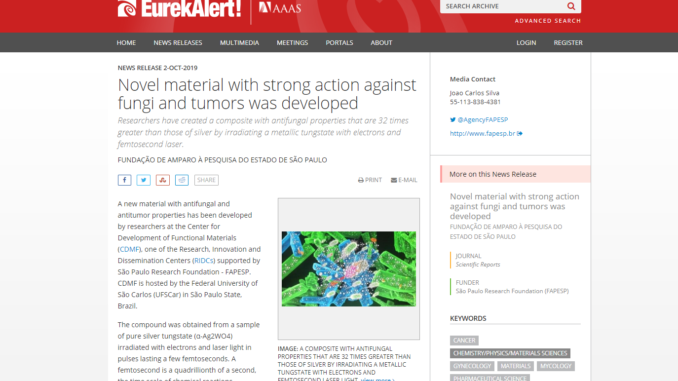
O artigo de autoria de pesquisadores do Centro de Desenvolvimento de Materiais Funcionais (CDMF) intitulado “Ag Nanoparticles/α-Ag2WO4 Composite Formed by Electron Beam and Femtosecond Irradiation as Potent Antifungal and Antitumor Agents” e publicado na edição do último dia 9 de julho no periódico ‘Scientific Reports’, do Grupo Nature, foi destaque em matéria publicada no EurekAlert!, serviço de divulgação de notícias sobre pesquisas científicas de alto impacto. Confira.
Novel material with strong action against fungi and tumors was developed
Researchers have created a composite with antifungal properties that are 32 times greater than those of silver by irradiating a metallic tungstate with electrons and femtosecond laser.
FAPESP – A new material with antifungal and antitumor properties has been developed by researchers at the Center for Development of Functional Materials (CDMF), one of the Research, Innovation and Dissemination Centers (RIDCs) supported by São Paulo Research Foundation – FAPESP. CDMF is hosted by the Federal University of São Carlos (UFSCar) in São Paulo State, Brazil.
The compound was obtained from a sample of pure silver tungstate (α-Ag2WO4) irradiated with electrons and laser light in pulses lasting a few femtoseconds. A femtosecond is a quadrillionth of a second, the time scale of chemical reactions involving exchanges of electrons between atoms and molecules. The new material is described in an article) published in Scientific Reports.
The growing use of semiconductors has unleashed the development of novel materials with a wide range of technological applications. One semiconductor family in particular that has drawn the attention of researchers in materials science is that of ternary tungsten oxides, such as metallic tungstates.
Silver tungstate, which belongs to this family, is an important inorganic material with applications in photocatalysis and photoswitches or as an alternative to conventional wide-band-gap semiconductors. Researchers affiliated with CDMF have been investigating silver tungstate for years.
“In an experiment performed in 2018, in which silver tungstate was irradiated with electrons, we observed under an electron microscope the appearance of tiny ‘hairs’ that grew on molecules of the material. These were nothing other than filaments of nanoparticles extracted from silver tungstate by electron irradiation,” said Elson Longo, Professor Emeritus in UFSCar’s Chemistry Department and CDMF’s principal investigator.
“Silver is a chemical element with bactericidal properties. Silver tungstate also has these properties, but what we found most striking was that after being modified by electron irradiation and silver filament construction, the composite displayed antifungal activity that was 32 times more effective than before irradiation.”
The modified composite’s antifungal activity was verified in Candida albicans, the fungus that causes candidiasis and thrush. The researchers cultured the fungus in Petri dishes. They already knew the minimum amount of silver tungstate required to eliminate the fungus and applied the same quantity of the modified composite to the culture. The result observed was similar.
The researchers then halved the volume of the substance and repeated the procedure, again eliminating the fungus. They repeated the procedure 32 times altogether, always with satisfactory antifungal results, demonstrating that the modified composite’s antifungal properties were 32 times more powerful than those of the original silver tungstate.
The composite’s antitumor action was tested in mouse bladder cancer cells, which were exposed for 24 hours to different concentrations (4.63 micrograms per milliliter, 11.58 μg/mL, 23.16 μg/mL, and 46.31 μg/mL).
According to Longo, the results showed a significant reduction in cell viability. The best result was obtained with a concentration of 11.58 μg/mL when bladder cancer cell viability fell by 80%.
After they demonstrated the composite’s antifungal and antitumor properties, the researchers at CDMF and UFSCar investigated its safety for future use in human patients.
Four concentrations of the irradiated silver tungstate composite that were above the optimal range of fungicidal activity (3.9 μg/mL – 31.2 μg/mL) were studied in a human gingival fibroblast cell line.
After incubation for 24?hours, the composite’s effect on cell viability, proliferation and morphology was evaluated by quantitative fluorometric assay and scanning electron microscopy.
“We found no statistically significant loss of cell viability at these concentrations compared to the control, showing that the composite poses no risk to human health,” Longo said.
Wave-particle duality
The study also achieved the important scientific milestone of demonstrating wave-particle duality experimentally. The wave-particle duality is a fundamental property of matter proposed in 1924 by French physicist Louis-Victor de Broglie (1892-1987), according to whom electrons and other discrete bits of matter, until then considered only to be material particles, could also have wave properties, depending on the experiment.
“In 1929, the Nobel Prize in Physics was awarded to de Broglie for the discovery that all matter can have wave properties. In the nine decades since, wave-particle duality has been observed and proven in a large number of scientific experiments, but until now, no one has demonstrated it experimentally using beams of particles [electrons in this case] and beams of waves [laser] to obtain identical alterations in compound materials,” Longo said.
“When we realized that electron radiation produced silver nanoparticle filaments on silver tungstate, we decided to investigate whether the same result could be achieved by using laser light, thereby experimentally proving the wave-particle duality proposed by de Broglie 95 years ago.”
The scientific literature currently points to the growing use of femtosecond laser radiation in material processing as a technique for obtaining novel compounds with highly attractive properties capable of driving technological advances.
“During the electron irradiation process, structural disorder is introduced into the silver tungstate electrons, and this plays a key role in the nucleation and growth of silver filaments,” Longo said.
In principle, segregating silver atoms by femtosecond laser radiation should occur in a similar manner but should theoretically be faster because a femtosecond laser pulse can supply maximum power in a very short amount of time.
“Given the expected segregation speed, therefore, the morphology of these silver nanoparticles would theoretically tend to be different under electron beam and femtosecond laser radiation,” Longo said.
The practical results exactly matched the theory. When submitted to femtosecond laser radiation, the surface of the silver tungstate was covered with silver nanoparticle filaments.
“By doing this, we succeeded in obtaining exactly the same result as with electron radiation, demonstrating wave-particle duality in practice,” Longo said.
###
A paper on this previous CDMF experiment was published in 2018, also in Scientific Reports. “We received a congratulatory letter from the journal’s editor, saying this paper in particular was one of the 100 most read articles on materials science published in the journal last year.”
About São Paulo Research Foundation (FAPESP)
The São Paulo Research Foundation (FAPESP) is a public institution with the mission of supporting scientific research in all fields of knowledge by awarding scholarships, fellowships and grants to investigators linked with higher education and research institutions in the State of São Paulo, Brazil. FAPESP is aware that the very best research can only be done by working with the best researchers internationally. Therefore, it has established partnerships with funding agencies, higher education, private companies, and research organizations in other countries known for the quality of their research and has been encouraging scientists funded by its grants to further develop their international collaboration. You can learn more about FAPESP at http://www.fapesp.br/en and visit FAPESP news agency at http://www.agencia.fapesp.br/en to keep updated with the latest scientific breakthroughs FAPESP helps achieve through its many programs, awards and research centers. You may also subscribe to FAPESP news agency at http://agencia.fapesp.br/subscribe.
A postagem original está disponível AQUI
CDMF
O CDMF é um dos Centros de Pesquisa, Inovação e Difusão (Cepids) apoiados pela Fundação de Amparo à Pesquisa do Estado de São Paulo (Fapesp), e recebe também investimento do Conselho Nacional de Desenvolvimento Científico e Tecnológico (CNPq), a partir do Instituto Nacional de Ciência e Tecnologia dos Materiais em Nanotecnologia (INCTMN).




